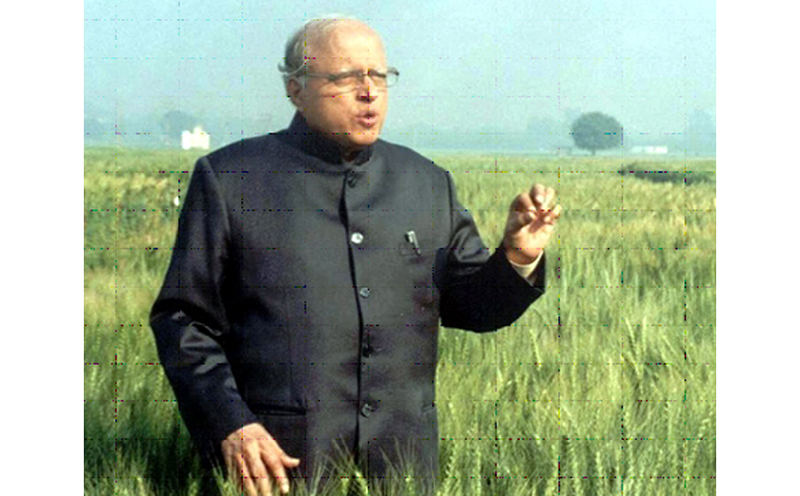(1925–2023)
Dr. Vivak M. Arya and Gourav Sudan
Monkombu Sambasivan Swaminathan, who passed away on September 28th , 2023, is called the father of the Green Revolution in India. He was born in Kumbakonam, Madras, on August 7, 1925. He studied at a local high school and completed his matriculation at Catholic Little Flower High School in Kumbakonam. He completed his undergrad in zoology from Maharaja’s College in Trivandrum, Kerela, presently known as University College. He graduated in agriculture from Madras Agriculture College, now known as TNAU, in 1944. In 1947, he moved to India’s prestigious institute, IARI New Delhi, for his postgraduate studies with a specialization in cytogenetics. His research interest was primarily in the genus Solanum. Dr. Swaminathan cleared the prestigious civil service examination and got selected for IPS services. But as his interest was always in the field of agriculture research, he opted out of the civil service. He got the fellowship from UNESCO at Wageningen Agriculture University in the Netherlands to continue his research on potato genetics. He worked there for almost eight months, then moved to the School of Agriculture at Cambridge University and completed his PhD in 1952. After the completion of his PhD, he moved to the United States of America for his post-doctoral research. After completing his post-doctoral research, he came back to his motherland, Bharat. When he returned to Bharat, there was a dearth of jobs in his field of specialization. Finally, he started his career as an assistant botanist at CRRI Cuttack under an Indica-Japonica rice hybridization program led by Krishnaswami Ramiah. The idea behind this program was to develop a fertilizer-responsive variety of rice that was suitable for the various rice-growing zones in the country. Later, he joined IARI New Delhi in October 1954 as an assistant cytogeneticist. Dr. M.S. Swaminathan became the head of the department in 1964. Dr. Swaminathan changed the name of the department from botany to genetics. The work and basic research that he had done added new knowledge, refined various concepts, and opened new avenues in the areas of cytogenetics in wheat.
Dr. Monkombu Sambasivan Swaminathan
Dr. Monkombu Sambasivan Swaminathan, 1925–2023. He played a pivotal role in the agriculture sector, particularly in the 1960s and 1970s, when major changes regarding the introduction of new breeds and technologies were introduced. He has been called the main architect of the Green Revolution in India for his role in introducing and developing high-yielding varieties of wheat and rice. The Green Revolution was initiated in the year 1960 by N. E. Borlaug, and it led to his winning the Noble Peace Prize in 1970 for his work in developing high-yielding varieties of wheat. In India, Dr. Swaminathan and Dr. Borlaug, both scientists, worked together to develop and produce new crop varieties. Both Dr. Swaminathan and Dr.Borlaug partnerships led to India’s Green Revolution in 1968. Dr. Swaminathan convinced farmers from the Indo-Gangetic plains, like Punjab, Haryana, and some parts of Uttar Pradesh, to grow these newly developed high-yielding varieties of wheat, and the result changed. The Green Revolution in India refers to a period when Indian agriculture was converted into an industrial system with the adoption of modern and advanced methods of technology such as HYV seeds, irrigation facilities, pesticides, and fertilizers. The varieties of wheat and rice that were introduced during the Green Revolution in India are Sonalika, Kalyan Sona in wheat, and Jaya, Ratna in rice.He served at a variety of institutions related to the field of agriculture both in India and abroad. In 1972, Dr.Swaminathan was appointed as the Director General of the Indian Council of Agricultural Research and worked until 1979. He was also the principal secretary in the Union agriculture ministry from 1979 to 1980 and a member of the Planning Commission from 1980 to 1882. He worked as an independent chairman of the Food and Agricultural Organization Council (1981–1985). He was president of various organizations viz: International Union for the Conservation of Nature and Natural Resources, the World Wide Fund for Nature, etc. He also chairs the National Commission on Farmers, which was constituted to address rising farmer suicides in India. Dr.Swaminathan was nominated as a member of the Rajya Sabha in 2007 by Dr. APJ Abdul Kalam. Dr.Swaminathan presented the Women’s Entitlements Bill 2011 to increase women’s role in farming due to the gradual migration of male farmers to cities in search of employment. Dr.Swaminathan received various national and international awards, including Padma Vibhushan, Padma Bhushan, Padma Shri, World Food Prize, Magsaysay Award, Bhatnagar Memorial Award, H.K. Firodia Award, Lal Bahadur Shastri National Award. He received the Fellowship of the Royal Society of London and also received fellowships from the leading countries of the world, including those from the USA, UK, USSR, Sweden, Japan, Italy, Germany, Bangladesh, Pakistan, and China. He was conferred with the Order of the Golden Heart of the Philippines, the Order of Agricultural Merit of France, the Order of the Golden Ark of the Netherlands, and the Royal Order of Sahametrei of Cambodia. China awarded him the Award for International Co-operation on Environment and Development. He wrote 254 papers in various prestigious international and national journals like Nature, Current Science, Science, Genetics, Radiation Research, etc., He also wrote various books. In 1988 Dr.Swaminathan set up M.S. Swaminathan Research Foundation, which is a registered society in Chennai. It works for science and technology and has become an epicenter for sustainable agriculture. At the end, we, the people of Bharat, are always indebted for his work and contribution to what he has done in the field of agriculture. He changed India’s image from a grain importer to a grain exporter. Dr. Swaminathan left for his heavenly abode on September 28, 2023. We can never forget his work in the field of agricultural sciences and will continue his legacy by following his footsteps.
(The authors are working in the field of NRM and climate change at SKUAST-Jammu.)


